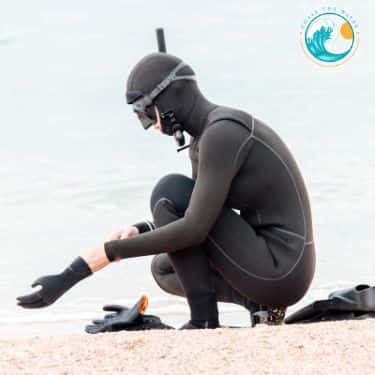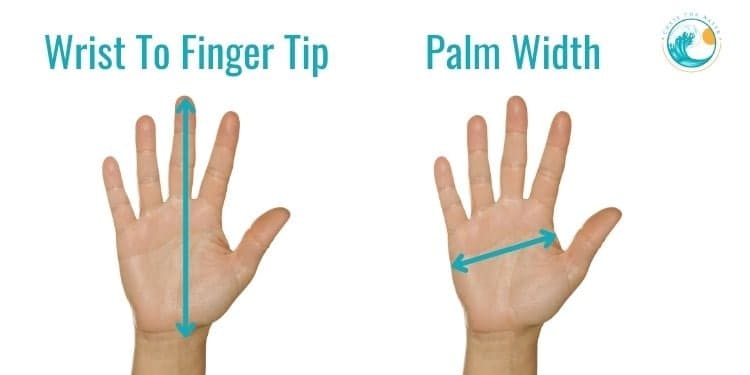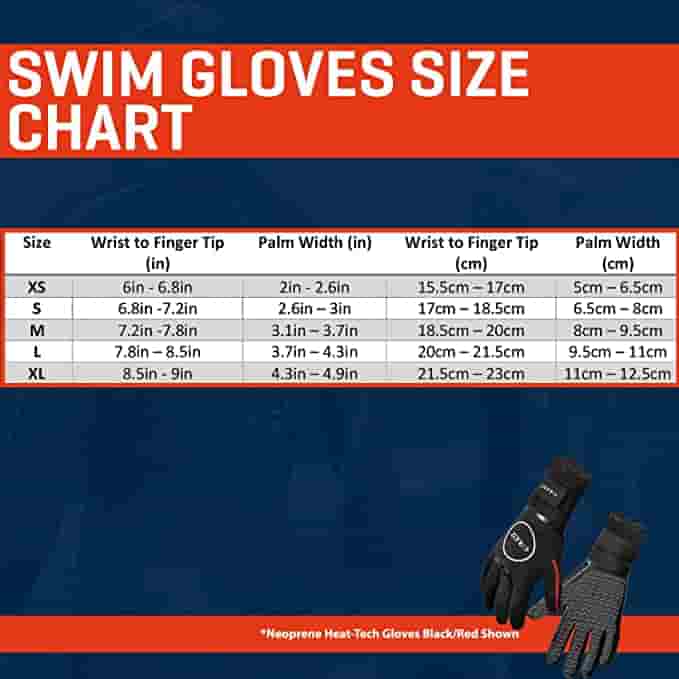Cold water swimming is an exhilarating experience but can become unbearable for many when hands and feet become cold.
Keeping your hands, feet and core warm is a great way to deal with cold water without having to wear a full wetsuit which can feel restrictive for many.
Typically, when choosing swim gloves for cold water, you need a snug fit and a material thickness that is thick enough to protect from the cold, yet thin enough to allow fingers to move freely and still feel the water while swimming.
Many have a love-hate relationship with neoprene swimming gloves, myself included.
We love that they keep our hands warm but hate that they create a barrier, reducing the “feel” of the water.
For me, the solution to a happy cold water swim is to find a pair of swimming gloves that tick all the boxes and feel like you are not actually wearing gloves.
In this article I will cover,
- Are neoprene gloves warm?
- How do you choose swim gloves?
- What thickness should swimming gloves be?
- Are 5mm neoprene gloves the best?
- Should neoprene gloves let water in?
- Do swim gloves slow you down?
- Best cold water swimming gloves

Are Neoprene Gloves Warm?
Typically, neoprene gloves are considered one of the warmest options for swimming in cold water. This is because neoprene is a thermal insulation material that traps water and warms it up.
Neoprene refers to the material that the gloves are made from. Most wetsuits are made from a neoprene material, so if you are already familiar with wetsuits (in particular any wetsuit that costs less than $200) you will be familiar with neoprene.
Neoprene gloves work just the same as a wetsuit, by trapping a very thin layer of water next to your skin. As your body heats up, it will heat this layer of water which will keep you warm.
The warmth of the neoprene gloves depends on:
- A snug fit
- The material thickness
If a pair of neoprene gloves are too loose, too much water gets trapped between your skin and the glove which is hard to heat up, or alternatively, the water in your gloves keeps being replaced with fresh cold water as there is so much space. This results in a neoprene glove that will not heat your hand efficiently.
In addition, to get a pair of neoprene gloves that are warm enough for your sport, you need to choose the correct thickness for the specified water temperature. I have discussed this in greater depth later in this article.
How Do You Choose Swim Gloves?
There are a few things to consider when choosing swim gloves for cold water. The most important are:
- Fit
- Material Thickness
What Is The Correct Fit For A Neoprene Glove?
The first thing to consider when choosing neoprene gloves is fit.
It is important to get a snug fit so that the gloves can effectively trap heat and prevent water from getting in.
A good general rule is to buy one size smaller if purchasing online. If you can try the gloves on before you buy, aim for a tight, snug fit. Not overly tight or restrictive, just very secure and snug.
Neoprene will expand when wet so your gloves will not feel so snug in the water.
If you try on a pair of neoprene gloves and you can easily slide your hands in and out, just like a regular glove, then the size is too large. In the water, this will feel loose and will not adequately warm your hands as too much cold water will slosh around in the glove.
The second is material thickness. You want to choose a material that is thick enough to insulate against the cold, but not so thick that it significantly reduces your dexterity.
How Are Swim Gloves Measured?
All good neoprene glove manufacturers will have dimensions specified for each of their glove sizes so you can get a good idea of what will work best for you.
Unfortunately, there is not a universal common size for neoprene gloves. As a result, one manufactures medium might be similar to another manufacturer’s small, so it is best to check the individual fit of each manufacturer.
As a general rule, neoprene gloves sizes are measured by the width of the palm of your hand and the length of the hand, which is measured from the tip of the middle finger to the wrist.
This is particularly important to know if you cannot try before you buy.
For example, one of my favourite brands for neoprene gloves is Zone3 which gives precise dimensions which correspond to their glove sizes.
Using the following chart from Zone3, you can measure your hand at home and compare it to the best Zone3 fit. This particular swim glove size chart is for the ZONE3 Neoprene Heat-Tech Warmth Swim Gloves. These are amazing neoprene gloves.
To get an idea of what “palm width” and “wrist to finger tip” refers to, here is an image of the dimensions you should measure your own hand first to get a good fit.

What Thickness Should Swimming Gloves Be?
Once you get a snug fit, the next important consideration when choosing neoprene gloves is to choose the best thickness for your own needs.
Many wonder how thick wetsuit gloves should be. There is not a definitive answer that will work for everyone, as we all have different tolerances to the cold.
A great place to start is to know the temperature of water you will be swimming in and then refer to the best recommended neoprene thickness is for that temperature.
I appreciate it is not possible to know exactly what temperature your water will be, but a ballpark figure is perfect.
For example, the average sea temperature in the UK ranges from 6-10°C in the winter and is around 15-20°C in the summer depending on your region. [source]
You can check websites such as The Beach Guide to get a better indication of the water temperature given the season.
Once you have some idea of the average water temperature you are swimming in, you can use the following table to select the appropriate neoprene thickness.
Neoprene thickness is specified in millimetres. (mm). This is an industry standard.
The following table is given as a guide only as everyone experiences the cold differently.
| Water Temperature | Neoprene Glove Thickness | Comments |
|---|---|---|
| 30°C – 40°C [86°F – 104°F] | No gloves required | This water temperature is pleasant and should feel nice and warm to swim in. |
| 25°C – 30°C [77°F – 86°F] | No gloves required / 1mm | This water temperature is cool. Generally, it is comfortable to swim in without gloves. For those who really hate the cold, 1mm gloves could be used. |
| 20°C – 25°C [68°F – 77°F] | 2mm or 3mm | This water temperature is classified as cold. You will start to feel your breathing being affected at this temperature. |
| 15°C – 20°C [59°F – 68°F] | 3mm or 4mm | This water temperature should be treated with caution as it is cold. We are starting to enter the region of dangerously cold. |
| 10°C – 15°C [50°F – 59°F] | 4mm or 5mm | This water temperature can be classified as dangerously cold. Many find this temperature range painful and hands will quickly become numb. |
| Below 10°C [50°F] | 5mm | Below this temperature is exceptionally cold and very dangerous. This temperature is painful and only for the experienced. |
Are 5mm Neoprene Gloves The Best?
It might seem logical to just buy 5mm neoprene gloves, the thickest and warmest on the market, as you will know that you have the warmest gloves.
The reason many swimmers, myself included, do not want to go straight for 5mm gloves is that you lose dexterity and a feel of the water.
As 5mm gloves are thick, you cannot feel much and your hands feel a bit clunky.
If you enjoy that wonderful swim feeling of placing your hand into the water, stretching it out in front of you and pulling, you will lose the beautiful contact of the water with thicker gloves.
Swimming with thicker gloves feels like swimming with paddles in my opinion.
Although I am very grateful for the warmth of my 5mm neoprene gloves in very cold water, if the water is warmer than 12°C (54°F) then I like to use 3mm neoprene gloves just to get that physical connection with the water.
Should Neoprene Gloves Let Water In?
Neoprene gloves should not be large enough to allow large amounts of water to get in and move around inside.
As your neoprene gloves get saturated, a thin layer of water will be trapped next to your skin. Your body temperature will heat this layer of water, keeping your hands warm.
If your neoprene gloves allow too much water in, then this will start to remove heat from your hands as the warm water is washed away.
A poor fit can result in too much water getting into neoprene gloves, which will greatly decrease their ability to keep your hands warm.
To avoid too much water getting into your neoprene gloves, it is a good idea to purchase neoprene gloves with a tapered wrist seal if you are not wearing a wetsuit or neoprene gloves with a long wrist that can fit underneath a wetsuit.

These options will create a seal on the wrist, which will reduce the level of fresh cold water getting into your gloves.
Do Neoprene Swim Gloves Slow You Down?
In theory, neoprene swim gloves will help you swim faster as they increase the surface area of your hands, similar to swim paddles or swim resistance gloves.
However, this initial speed boost does not last very long for many swimmers as your hands become heavy with the gloves.
Similar to using swim paddles, your arms will tire as you are pulling extra water with each stroke and this will cause you to slow down as your stroke feels heavier.
The solution is to train for this using swim paddles or practice building your strength to build up the endurance to maintain a fast speed while swimming with neoprene gloves.
Alternatively, you can check out swim resistance gloves, which will help you adjust to using gloves as you swim, while building strength.
Best Cold Water Swimming Gloves
Here is a list of my top picks for the best cold water swimming gloves. Nearly all these gloves come in a variety of hand sizes and thickness.
ZONE3 Neoprene Heat-Tech Warmth Swim Gloves
- Great snug fit
- Excellent quality
- Excellent wrist sealing to prevent the ingress of excess water
TWF 3mm Gloves
- Very affordable
- Nice wrist design
- Glued and blind stitched to reduce flushing.
- Very warm and a snug fit.
PAWHITS Wetsuit Gloves 3mm Neoprene Gloves Thermal Anti-slip Diving Gloves for Men Women
- Very affordable
- Nice anti-slip palms
- Good for the casual swimmer

O’Neill 3 mm Epic Gloves
- Made from flexible neoprene.
- Excellent grip
- Great for all watersports
Final Thoughts
Swim gloves can be a great way to keep your hands warm in cold water, but it’s important to choose the right type of glove for your needs.
Thick gloves will make you less agile and reduce your feel for the water, while thin gloves may not provide enough warmth.
Neoprene gloves should fit snugly so that they don’t let in too much water, which can make your hands cold.
And finally, keep in mind that swim gloves will add resistance to your stroke, so you may need to build up some extra strength to swim at your usual pace.
Happy swimming!





